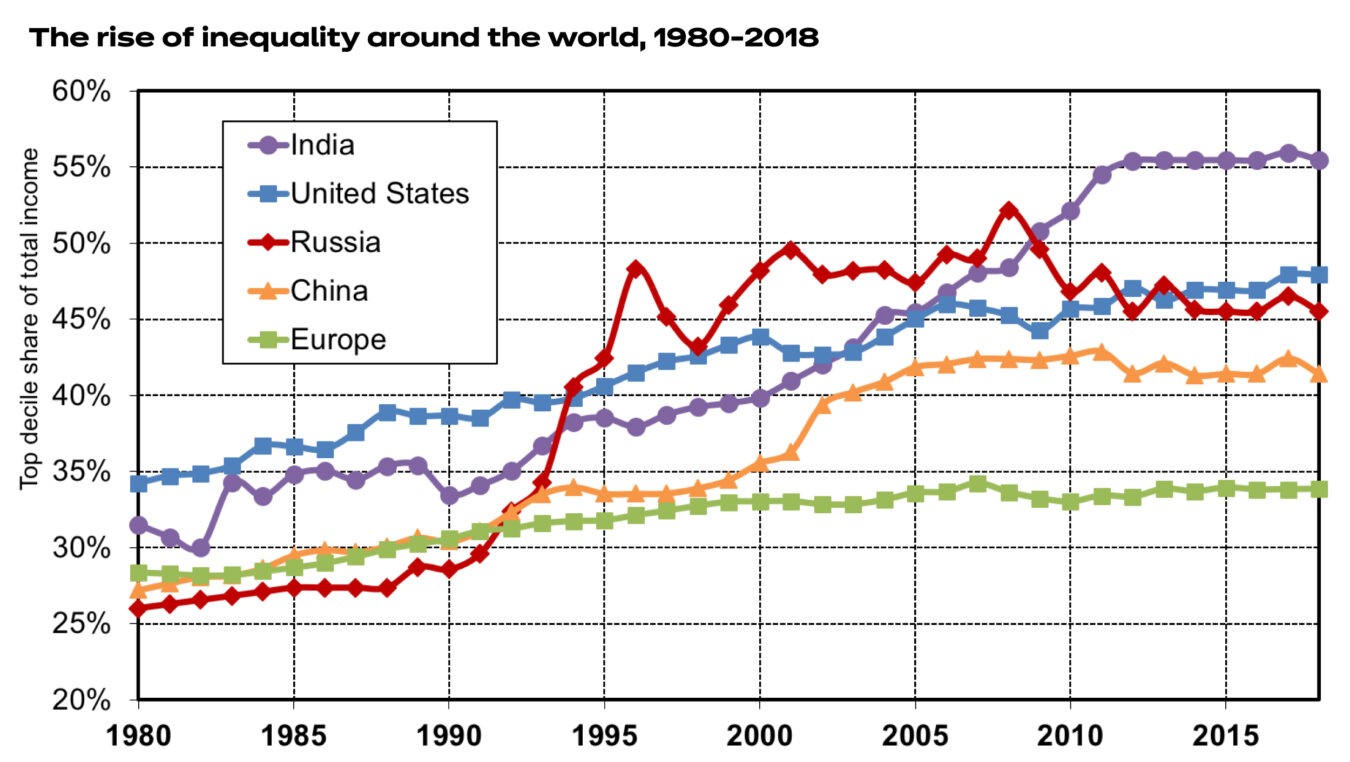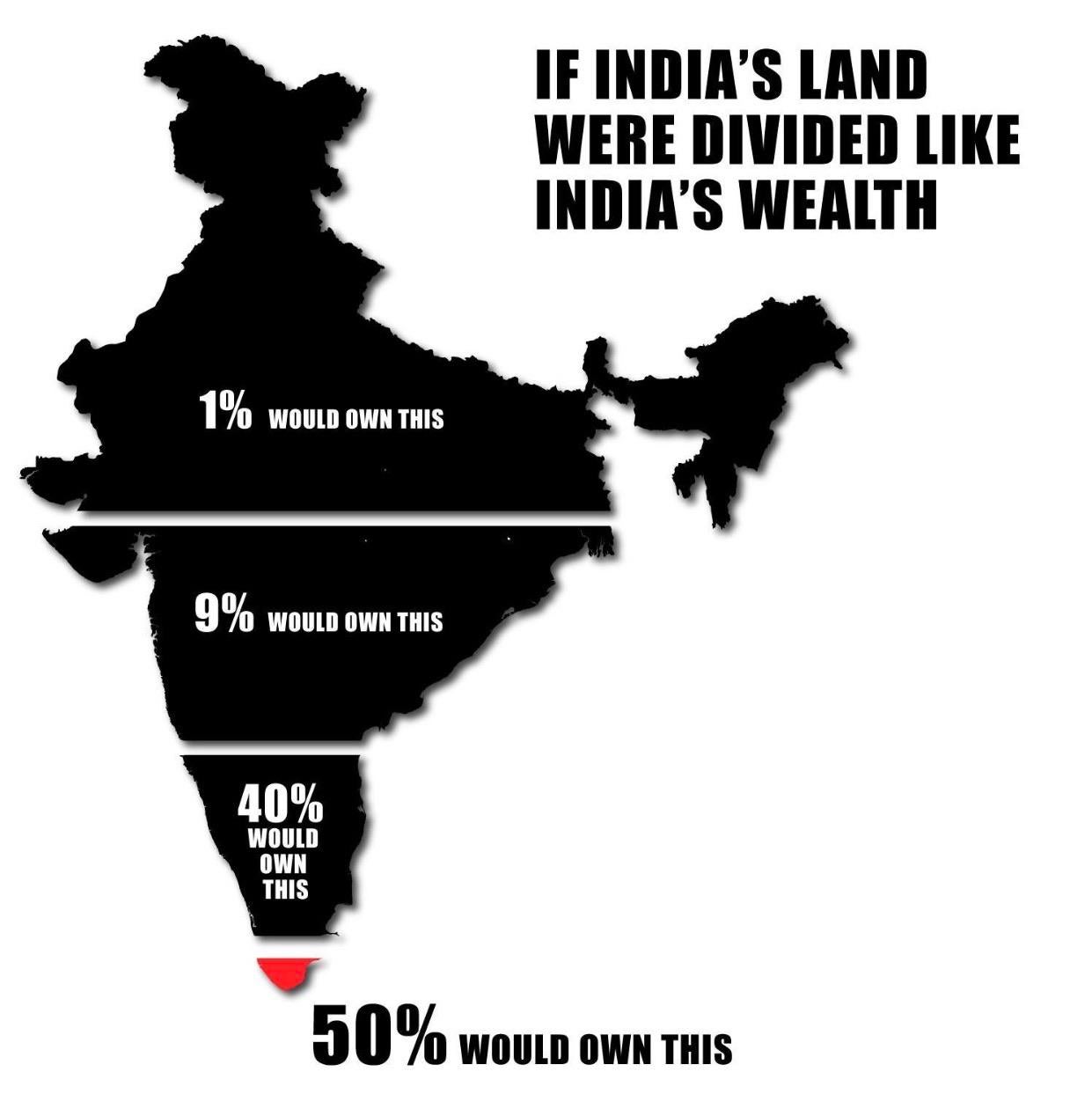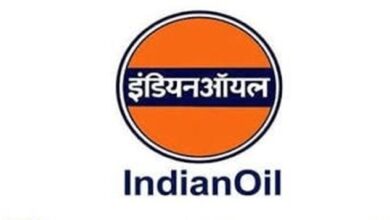The income Inequality of India has impacted the small-scale industries severely, but is the scenario going to evolve in the wake of employment opportunities?

Look around us, has it ever crossed our minds how drastically people suffer in the rural areas? Precisely, the human tendency would only enrich looking at the lavish life of the big millionaires, but is there any significant reason as to why they have excelled their way up to the top. Let’s find out:
Economic reforms of India focus on generating more wealth into the system, but does it affect the distribution of wealth equally to every citizen of India. India is one of the fastest-growing economies in the world, yet an unequal country in allocating incentives to different scales of classes. Contrarily, the huge businessmen exploit income equality by gaining an advantage over the proportion of poor people residing in remote areas.
“What is particularly worrying in India’s case is that economic inequality is being added to a society that is already fractured along the lines of caste, religion, region, and gender.” Income inequality has been rooting up the reigns of India for over three years, where the richest have gained a huge part of the wealth generated through crony capitalism and inheritance.
Poor continue to suffer from the chronic under-investment by the Government in remote areas affecting their income drastically. The people who have escaped the chords of poverty way before remain vulnerable to income mobilization. It causes disbelief within the framework of the system creating uncertainty in the hindsight of people.

WHAT HAS INTENSIFIED THE GAP OF ECONOMIC DISPARITY?
At the national level, the income disparity in India goes back to the early 1980s, when the economic reforms were not so structured and organized to reflect the differences between the distribution of income.
According to a survey, economic liberalization in the 1980s created massive havoc in the market, and since then income inequality substantially started growing in the developed economies.
In India, the top-notch Companies’ shares grew from 30% in 1980 to over 56% as of the latest in 2019. China and India scaled their economies simultaneously at that time, but the contrasting figures in the rise of inequality have left something for us to ponder upon. “The lower rise of inequality in China was associated with stronger growth rates and much faster poverty eradication compared with India, showing that more economic growth need not necessarily mean increased inequality,” the report further added.
Economic policies of countries differ in their approach and objectives, as lower inequality levels can accelerate poverty reduction and economic growth rates of the GDP simultaneously. The estimates of income inequality place India amongst the countries with higher exponential inequality rates internationally.
CURRENT SCENARIO OF INCOME INEQUALITY IN INDIA
Over the last few years, India has regained its position in being one of the top Middle eastern countries in sharing the income between the top-notch industries. While the widening gap is alarming, it is noteworthy that almost 90% of Indians are vulnerable to disparity among distinctive income classes.
Furthermore, intergenerational mobility is low, causing pervasive inequality of opportunities to the rural and the urban sector. Inequality trends patterned by income mobility, and even though people already exited poverty decades ago, they still remain vulnerable to dragging back into the frame. Such is the threat of Income Mobilization!
The structural model should contemplate the organizational changes it needs to avert in the industry to make India a self-reliant and self-dependent force. In the current scenario, the poor are extremely throttled to suffer long-term. Although the economic reforms foresee a surge in every quarter, the poverty decline is becoming increasingly more difficult to achieve due to the lack of structure right from the roots of the problem.

WHAT ARE THE RELATED FACTORS TO KNOW MORE ABOUT THE INEQUALITY TRENDS?
EDUCATIONAL FACTORS
While the rich are seeking more knowledge than ever in the present working system, the poor are failing due to the lack of technological advancements in the rural areas. What signifies the dilemma is that almost two-thirds of the population in the villages do not even know how to operate a smartphone in today’s world. The Global Education Monitoring report, published earlier this year, highlights the need for education systems to be inclusive and equitable in their approach to separate the segregation of schooling from the educational network.
Coincidentally, social inequalities and educational inequalities go hand in hand. Moreover, the aspect of quality in education is overlooked in the rural areas which reinforces disparity among the qualifications of the concerned people.
SOCIAL FACTORS
The disparity is said to arise with destiny. It is not like individuals do not make their way out of the bizarre circumstances, but it requires a miracle to change the overlook of anyone’s story more often than not.
In India, by birth, we are judged by our caste, religion, and income status, and accordingly, we develop our lifestyle surrounding reality. Social inequalities can establish through the reigns of discriminatory legislation.
The way people behave to gender inequality, racial inequality often tends to decrease the opportunities for individuals from localized areas to generate wealth for themselves.
HAS THE GOVERNMENT INITIATED EFFORTS TO SUSTAIN EQUALITY WITHIN THE RANKS?
The scrutiny around the Government’s delay of action has always been there. But in this case, measures have taken place to eliminate income inequality from India and begin the rise of a newly built Self-sufficient and self-reliant nation.
Detailing about the measures are as follows:
Land Reforms and Redistribution of Ceiling Surplus Land
India’s agricultural lands comprise most of the income inequality dwelling around the rural areas. As these lands are in the full force of the big landlords, they exploit the farmer’s needs according to their interests.
The Zamindari system prevailing in India has proven to be a curse for the hard-working individuals as the majority of the proportion acquires the name of the landlords. Various legislative measures were taken to abolish this system but they failed due to the lack of desire on the part of the Government, and the farmers.
The redistribution of agricultural land also possesses minor control in poverty alleviation.
Restrictive Trade Practices:
In 1960, after facing adversities of monopoly, the Monopolies and Restrictive Trade Practices Act were passed with a view of hindering the income inequality from concentration to a large pool of stranding individuals. The committee formed was to regulate the working of the erring enterprises, as these measures were soon cast out as inadequate and ineffective exhibited more troubles for the interests of the small-scale industries.
Furthermore, under the present era of liberalization of the economic sector, the Monopoly is looking to strengthen its reach by expanding its units in the remote areas as well resulting in the aggravation of the economic disparities.
Employment Program and Wage Policies:
The menace of unemployment surged up in the wake of the Coronavirus pandemic, not just in India but across the globe. The Finance Ministry of India under the regulations of the Government introduced some special employment programs from the Fourth Plan onwards to provide some malice to the unemployed to gain business or job opportunities.
These programs include Crash Scheme for Rural Unemployment, the Drought Prone Areas Programme, Food for Work Programme, self-employment schemes for engineers, employment schemes for educated unemployment, etc.

THE WAY FORWARD AND HOW THE EMERGENCE OF THE EPIDEMIC IMPACT THE WORKING? IS IT A BOON OR A CURSE FOR THE UNEMPLOYED?
What we can perceive through the failed measures is that there was a lack of application and desire from both ends of the needle. If the situation needs upliftment from all the troublesome times, then the farmers along with the support of the government authorities, have to fight their battle and pave their way through to success.
In the wake of the pandemic, almost 40% of Indians in the private sector have either shifted or resigned from their jobs which created a deep hole in the economic sector. Alas, the lockdown eased, otherwise, the situation was going to head towards an enormous downfall.
During the lockdown, the situation was to sit tight and wait for the very right moment to bounce back. Gradually, people motivate themselves to reshape their careers by looking forward to the opportunities left vacant due to inactivity.
From being inactive for months to finding jobs in a confined sector, tells us the story of the modern man who is not willing to give up at any cost.
CONCLUSION
Recently, India is emerging as a dynamic force in the global markets, and more production is scaling up in the wings, there will be more need for skillful and diligent people to involve in the activities of various business tycoons.
Income inequality roots up from the early decades and accelerated with a swift pace, to completely combat it will be challenging for any government. High inflation rates can lead to aggravation of income disparity, as the poor will not be able to afford the necessities of a standard lifestyle.






